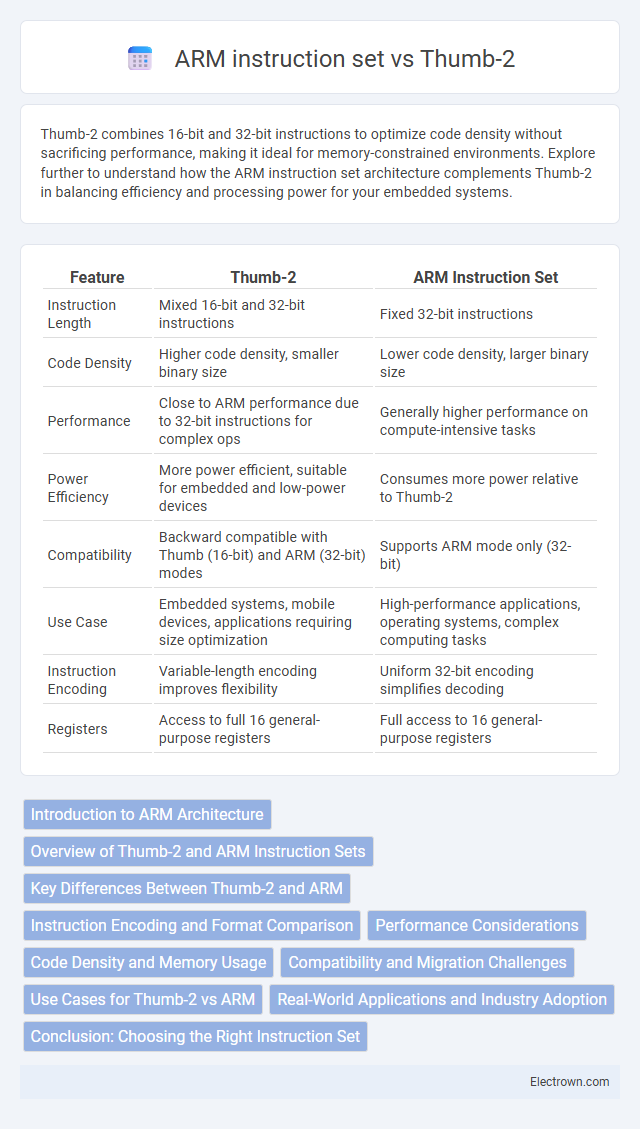Thumb-2 combines 16-bit and 32-bit instructions to optimize code density without sacrificing performance, making it ideal for memory-constrained environments. Explore further to understand how the ARM instruction set architecture complements Thumb-2 in balancing efficiency and processing power for your embedded systems.
Table of Comparison
| Feature | Thumb-2 | ARM Instruction Set |
|---|---|---|
| Instruction Length | Mixed 16-bit and 32-bit instructions | Fixed 32-bit instructions |
| Code Density | Higher code density, smaller binary size | Lower code density, larger binary size |
| Performance | Close to ARM performance due to 32-bit instructions for complex ops | Generally higher performance on compute-intensive tasks |
| Power Efficiency | More power efficient, suitable for embedded and low-power devices | Consumes more power relative to Thumb-2 |
| Compatibility | Backward compatible with Thumb (16-bit) and ARM (32-bit) modes | Supports ARM mode only (32-bit) |
| Use Case | Embedded systems, mobile devices, applications requiring size optimization | High-performance applications, operating systems, complex computing tasks |
| Instruction Encoding | Variable-length encoding improves flexibility | Uniform 32-bit encoding simplifies decoding |
| Registers | Access to full 16 general-purpose registers | Full access to 16 general-purpose registers |
Introduction to ARM Architecture
ARM architecture is a widely used RISC-based processor design known for its power efficiency and performance in embedded and mobile devices. The Thumb-2 instruction set extends the original Thumb by blending 16-bit and 32-bit instructions, enhancing code density and execution speed without compromising compatibility with ARM's 32-bit instruction set. This hybrid approach enables developers to optimize applications for both memory footprint and processing power, making ARM architecture highly versatile across various platforms.
Overview of Thumb-2 and ARM Instruction Sets
Thumb-2 is an enhanced instruction set architecture developed by ARM that combines 16-bit and 32-bit instructions, offering improved code density without sacrificing performance. The ARM instruction set primarily uses 32-bit fixed-length instructions designed for high-performance applications. Understanding the distinction helps you optimize software by leveraging Thumb-2's compact encoding for memory-efficient embedded systems while utilizing ARM's full 32-bit instruction set for compute-intensive tasks.
Key Differences Between Thumb-2 and ARM
Thumb-2 combines 16-bit and 32-bit instruction sets to improve code density and performance, while ARM uses a fixed 32-bit instruction length optimized for higher processing speed. Thumb-2 instructions offer enhanced efficiency in memory usage and power consumption, making them ideal for embedded systems with resource constraints. ARM instructions provide more comprehensive instruction sets and greater control over hardware features, often used in applications requiring high-performance computing.
Instruction Encoding and Format Comparison
Thumb-2 instruction set employs a mixed 16-bit and 32-bit encoding scheme, optimizing code density while maintaining performance, whereas the ARM instruction set uses a uniform 32-bit fixed-length encoding format. Thumb-2's variable-length instructions allow for more compact code and improved memory utilization, contrasting with ARM's fixed 32-bit instructions that facilitate simpler decoding and execution pipelines. The encoding format of Thumb-2 supports a richer set of operations within smaller instruction sizes, enhancing efficiency in embedded systems where memory and power are constrained.
Performance Considerations
Thumb-2 combines 16-bit and 32-bit instructions to improve code density while maintaining near ARM instruction set performance, enabling more efficient use of memory and cache. ARM instructions, fully 32-bit, provide higher raw execution speed due to their more straightforward decode pipeline and richer instruction set, benefiting computation-intensive applications. Performance considerations depend on the balance between memory bandwidth constraints and processing power requirements, with Thumb-2 excelling in embedded systems where compact code size and energy efficiency are critical.
Code Density and Memory Usage
Thumb-2 instruction set significantly improves code density compared to the traditional ARM instruction set by combining 16-bit and 32-bit instructions, allowing more compact and efficient code. This increased code density leads to reduced memory usage, which is particularly beneficial in embedded systems with limited memory resources. As a result, Thumb-2 enhances performance by optimizing memory bandwidth and reducing cache misses, making it ideal for resource-constrained applications.
Compatibility and Migration Challenges
Thumb-2 extends the ARM instruction set by combining 16-bit and 32-bit instructions, enhancing code density while maintaining compatibility with existing ARM cores. Migration challenges arise from differences in instruction encoding and performance characteristics, requiring developers to optimize code carefully to balance speed and memory usage. Your transition to Thumb-2 demands thorough testing to ensure seamless integration with legacy ARM applications and maintain system stability.
Use Cases for Thumb-2 vs ARM
Thumb-2 is ideal for applications requiring efficient code density and low memory usage, such as embedded systems and IoT devices, where conserving power and storage is critical. The ARM instruction set offers higher performance and is suited for compute-intensive tasks, including multimedia processing and high-end embedded applications. Your choice depends on whether your project prioritizes compact code or raw processing power.
Real-World Applications and Industry Adoption
Thumb-2 instruction set enhances code density and performance, making it ideal for embedded systems in automotive, IoT, and consumer electronics where memory efficiency and fast execution are critical. ARM instruction set, with its robust feature set and compatibility, remains dominant in high-performance applications like smartphones, tablets, and servers, supporting complex operating systems and software ecosystems. Your choice between Thumb-2 and ARM should consider the specific application requirements for power efficiency, code size, and processing power to maximize industry adoption benefits.
Conclusion: Choosing the Right Instruction Set
Choosing between Thumb-2 and the ARM instruction set depends on your priorities for code density and performance. Thumb-2 offers improved code density and better memory utilization by mixing 16-bit and 32-bit instructions, making it ideal for embedded systems with limited resources. Your decision should balance the need for compact code with the performance demands of your application.
Thumb-2 vs ARM instruction set Infographic

 electrown.com
electrown.com